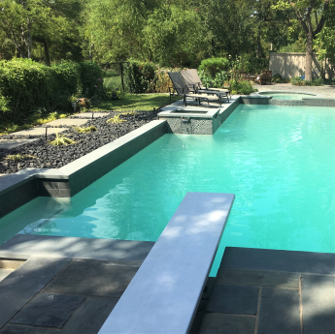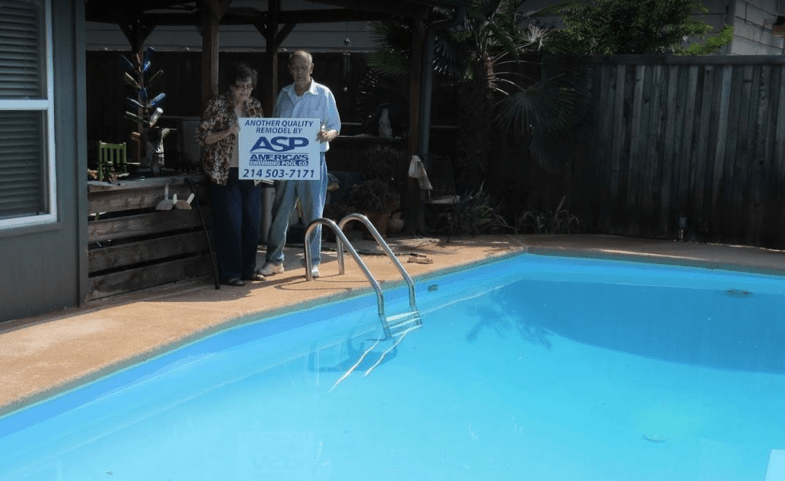Types of Plaster
White Plaster is a white marble aggregate (sand), white cement and water. Applied at a thickness of about one half an inch, white plaster was the standard in the pool industry. Recent supplies of the white marble aggregate are not as long lasting as they have been in years past. It is an economical choice and has a desirable surface for swimmers. Expect a 5-10-year life span.
Colored Plaster is a white marble aggregate, white cement, pigment, and water. Adding pigment to the plaster in the mixing creates a color. But the pigment may be unpredictable and have flawed traits in the plaster. Expect unevenness in the color and variations in the shading and density. Inevitably, fading will occur over time. It has the same desirable surface for swimmers because it is smooth.
Quartz Plaster is a quartz aggregate, white cement, pigment (if applicable) and water. Quartz plaster is more durable due to its quartz content. Like colored plaster, pigmented quartz plaster will be inconsistent in color and change in appearance over time.
Pebble Plaster is a pebble aggregate, white cement, pigment (if applicable) and water. Pebble plaster replaces the white sand used in white plaster with a pebble aggregate (smooth river pebbles of varying colors and sizes) giving the plaster a pebble finish throughout. It is offered in a broad range of colors with its pebbles and pigmentation (if applicable), the three-quarter-inch finish is a long-lasting surface due to the pebbles, 15-20 years. Pigmented pebble plaster will be inconsistent in color due to the natural stones and can change in appearance over time. The curing of new plaster will occur over the next 10-12 months.
Note: for more plaster information, please visit the National Plasterer’s Council website.
Water filling instructions
It is relatively simple to fill a freshly plastered pool with water. But there are some important facts and processes to follow. It is imperative that the flow of water is not stopped or paused when filling a newly plastered pool until it’s full (above the tile line) because disrupting the water flow can create rings in the plaster at the point where water rests.
Place a clean rag or plastic bottle with holes on the end of the hose (to prevent damage to the new plaster). Place it in the deepest point with the valve wide open. Do not turn off the water until the pool is full.
Once the pool is full, it is recommended that you have a seven-day start-up which can be provided by an ASP Dallas technician.
New Plaster Care
The reason why we share the New Plaster Care Instructions with you is to inform you and educate you about what you should and should not do with new plaster. The biggest impact an owner can make to a newly plastered pool’s surface is by being diligent in brushing the plaster surface. Here are some essential plaster care basics:
Critical Do’s and Don’ts:
Your new plaster needs to cure and hydrate. Newly installed plaster begins to hydrate immediately during the filling of the pool and does most of its hydration during the next 28 days. The first 4 weeks are critical as your new plaster is most susceptible to staining, discoloration and scaling during this period. Typically, swimming can resume 48 hours after the pool has been filled with water
Critical Do’s
• The filtration system should run continuously during the first 72 hours
• Daily brushing can begin as soon as the pool is filled and the filtration system operating
• Brush the walls and floor in a downward motion toward the bottom drain
• Use a non-metal bristle brush on a telescopic pole (please let us know if you need to purchase one)
• Brush 2 times a day for 2 weeks (frequent brushing promotes a smoother surface)
• Do not scrub, just a light brushing (do not take more than 15-20 minutes for the entire pool)
• Do not worry about hard to get spots – you may use a hand brush while swimming in a downward motion
• Adjust the water chemistry; alkalinity should be 80 ppm to 120 ppm, pH level should be 7.2 to 7.6, adjust calcium hardness as needed
• Always follow chemical product label instructions
Critical Don’ts
• Bare feet only (no pool shoes, flippers, etc.) for the first 2 weeks)
• No pool cleaning devices (Polaris, Ray-Vac, Kreepy-Krauly) for the first 28 days after the fill
• No dogs, pets or other objects which are hard for the first 2 weeks
• Do not run the pool heater for the first 2 weeks
• Do not add salt for the first 28 days (for salt cell pool systems only)
Who We Are
An Award-winning company, ASP Dallas creates a backyard oasis centered around your swimming pool. We are experts who are passionate about pools. We strive to bring resort-quality service, reliability, and peace of mind regarding your swimming pool investment. It is our hope that your pool will bring friends and families together for outdoor fun and memories that will last a lifetime.
Contact us online or give us a call (214) 740-3814 to come visit our showroom!



